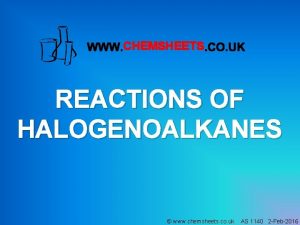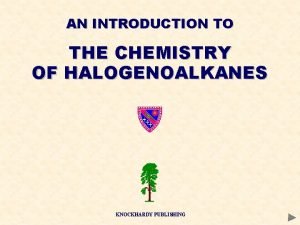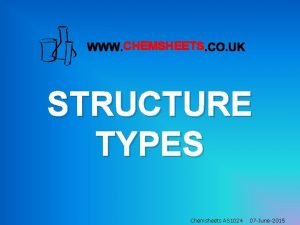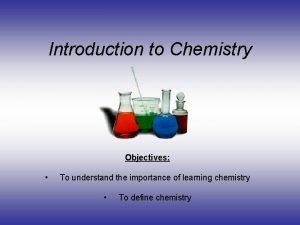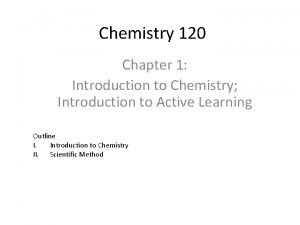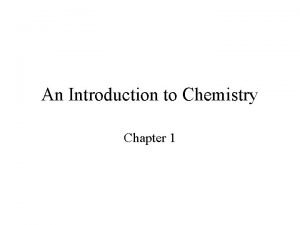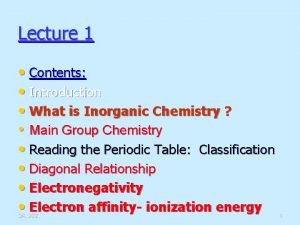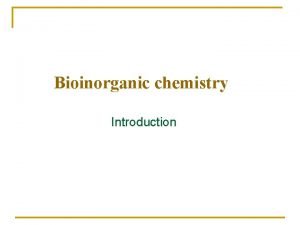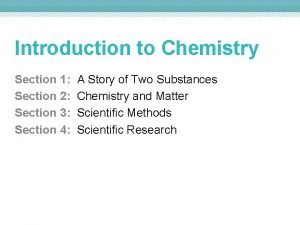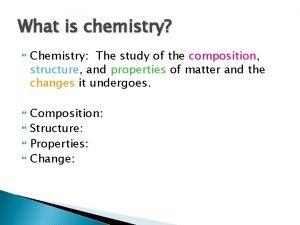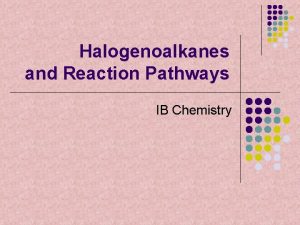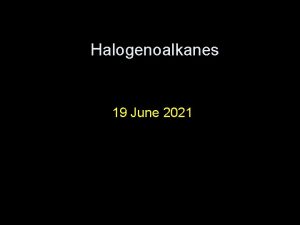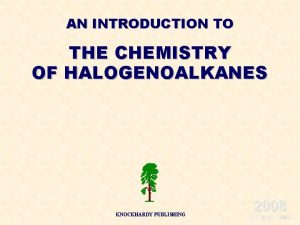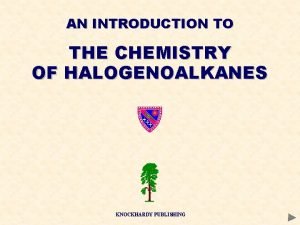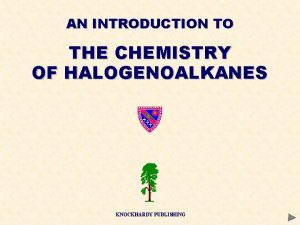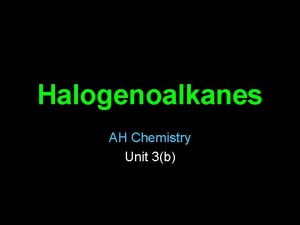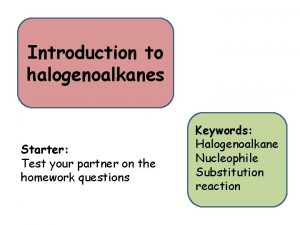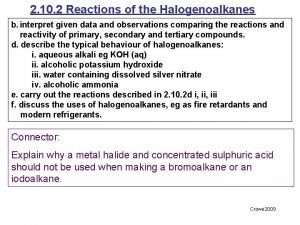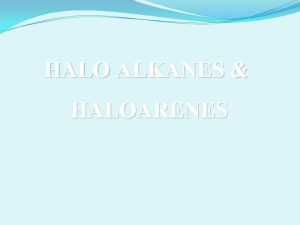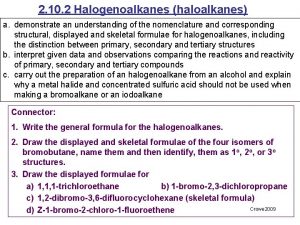AN INTRODUCTION TO THE CHEMISTRY OF HALOGENOALKANES THE


















- Slides: 18

AN INTRODUCTION TO THE CHEMISTRY OF HALOGENOALKANES

THE CHEMISTRY OF HALOGENOALKANES CONTENTS • Structure of halogenoalkanes • Physical properties of halogenoalkanes • Nucleophilic substitution - theory • Nucleophilic substitution - examples • Uses of haloalkanes • CFC’s

THE CHEMISTRY OF HALOGENOALKANES Before you start it would be helpful to… • Recall the definition of a covalent bond • Be able to balance simple equations • Be able to write out structures for hydrocarbons and their derivatives • Understand the different types of bond fission • Recall the chemical properties of alkanes, alkenes and alcohols

STRUCTURE OF HALOGENOALKANES Format Contain the functional group C-X where X is a halogen (F, Cl, Br or I) Halogenoalkanes - halogen is attached to an aliphatic skeleton - alkyl group Haloarenes - halogen is attached directly to a benzene (aromatic) ring

STRUCTURE OF HALOGENOALKANES Format Contain the functional group C-X where X is a halogen (F, Cl, Br or I) Halogenoalkanes - halogen is attached to an aliphatic skeleton - alkyl group Haloarenes Structural difference - halogen is attached directly to a benzene (aromatic) ring Halogenoalkanes are classified according to the environment of the halogen PRIMARY 1° SECONDARY 2° TERTIARY 3°

STRUCTURE OF HALOGENOALKANES Format Contain the functional group C-X where X is a halogen (F, Cl, Br or I) Halogenoalkanes - halogen is attached to an aliphatic skeleton - alkyl group Haloarenes Structural difference - halogen is attached directly to a benzene (aromatic) ring Halogenoalkanes are classified according to the environment of the halogen PRIMARY 1° Names SECONDARY 2° TERTIARY 3° Based on original alkane with a prefix indicating halogens and position. CH 3 CH 2 Cl 1 -chloropropane CH 3 CHCl. CH 3 2 -chloropropane CH 2 Cl. CH 3 1, 2 -dichloropropane CH 3 CBr(CH 3)CH 3 2 -bromo-2 -methylpropane

STRUCTURAL ISOMERISM IN HALOGENOALKANES Different structures are possible due to. . . Different positions for the halogen and branching of the carbon chain 1 -chlorobutane 2 -chloro-2 -methylpropane 2 -chlorobutane 1 -chloro-2 -methylpropane

PHYSICAL PROPERTIES Boiling point Increases with molecular size due to increased van der Waals’ forces Mr bp / °C chloroethane 64. 5 13 1 - chloropropane 78. 5 47 1 -bromopropane 124 71 Boiling point also increases for “straight” chain isomers. Greater branching = lower inter-molecular forces bp / °C 1 -bromobutane CH 3 CH 2 CH 2 Br 101 2 -bromobutane CH 3 CH 2 CHBr. CH 3 91 (CH 3)3 CBr 73 2 -bromo -2 -methylpropane Solubility Halogenoalkanes are soluble in organic solvents but insoluble in water

NUCLEOPHILIC SUBSTITUTION Theory • • • halogens have a greater electronegativity than carbon electronegativity is the ability to attract the shared pair in a covalent bond a dipole is induced in the C-X bond and it becomes polar the carbon is thus open to attack by nucleophiles nucleophile means ‘liking positive’ the greater electronegativity of the halogen attracts the shared pair of electrons so it becomes slightly negative; the bond is now polar.

NUCLEOPHILIC SUBSTITUTION Theory • • • halogens have a greater electronegativity than carbon electronegativity is the ability to attract the shared pair in a covalent bond a dipole is induced in the C-X bond and it becomes polar the carbon is thus open to attack by nucleophiles nucleophile means ‘liking positive’ the greater electronegativity of the halogen attracts the shared pair of electrons so it becomes slightly negative; the bond is now polar. NUCLEOPHILES • • • ELECTRON PAIR DONORS possess at least one LONE PAIR of electrons don’t have to possess a negative charge are attracted to the slightly positive (electron deficient) carbon examples are OH¯, CN¯, NH 3 and H 2 O (water is a poor nucleophile) OH¯ CN¯ NH 3 H 2 O

NUCLEOPHILIC SUBSTITUTION - MECHANISM the nucleophile uses its lone pair to provide the electrons for a new bond the halogen is displaced - carbon can only have 8 electrons in its outer shell the result is substitution following attack by a nucleophile the mechanism is therefore known as - NUCLEOPHILIC SUBSTITUTION

NUCLEOPHILIC SUBSTITUTION - MECHANISM the nucleophile uses its lone pair to provide the electrons for a new bond the halogen is displaced - carbon can only have 8 electrons in its outer shell the result is substitution following attack by a nucleophile the mechanism is therefore known as - NUCLEOPHILIC SUBSTITUTION Points the nucleophile has a lone pair of electrons the carbon-halogen bond is polar a ‘curly arrow’ is drawn from the lone pair to the slightly positive carbon atom a ‘curly arrow’ is used to show the movement of a pair of electrons carbon is restricted to 8 electrons in its outer shell - a bond must be broken the polar carbon-halogen bond breaks heterolytically (unevenly) the second ‘curly arrow’ shows the shared pair moving onto the halogen now has its own electron back plus that from the carbon atom it now becomes a negatively charged halide ion a halide ion (the leaving group) is displaced

NUCLEOPHILIC SUBSTITUTION - RATE OF REACTION Basics An important reaction step is the breaking of the carbon-halogen (C-X) bond The rate of reaction depends on the strength of the C-X bond C-I 238 k. Jmol-1 C-Br 276 k. Jmol-1 C-Cl 338 k. Jmol-1 C-F 484 k. Jmol-1 weakest - easiest to break strongest - hardest to break

NUCLEOPHILIC SUBSTITUTION AQUEOUS SODIUM HYDROXIDE Reagent Conditions Product Nucleophile Equation Aqueous* sodium (or potassium) hydroxide Reflux in aqueous solution (SOLVENT IS IMPORTANT) Alcohol hydroxide ion (OH¯) e. g. C 2 H 5 Br(l) + Na. OH(aq) ——> C 2 H 5 OH(l) + Na. Br(aq) Mechanism * WARNING It is important to quote the solvent when answering questions. The reaction (and the one with water) is known as HYDROLYSIS

NUCLEOPHILIC SUBSTITUTION AQUEOUS SODIUM HYDROXIDE ANIMATED MECHANISM

USES OF HALOGENOALKANES Synthetic The reactivity of the C-X bond means that halogenoalkanes play an important part in synthetic organic chemistry. The halogen can be replaced by a variety of groups via nucleophilic substitution. Polymers Many useful polymers are formed from halogeno hydrocarbons Monomer Polymer Repeating unit chloroethene poly(chloroethene) PVC tetrafluoroethene poly(tetrafluoroethene) PTFE Chlorofluorocarbons - CFC’s dichlorofluoromethane trichlorofluoromethane bromochlorodifluoromethane CHFCl 2 CF 3 Cl CBr. Cl. F 2 CCl 2 FCCl. F 2 - (CH 2 - CHCl)n - (CF 2 - CF 2)n - refrigerant, aerosol propellant, blowing agent fire extinguishers dry cleaning solvent, degreasing agent

PROBLEMS WITH CFC’s AND THE OZONE LAYER CFC’s have been blamed for damage to the environment by thinning the ozone layer Ozone absorbs a lot of harmful UV radiation However it breaks down more easily in the presence of CFC's CFC’s break up in the atmosphere to form radicals Free radicals catalyse the breaking up of ozone CF 2 Cl 2 ——> CF 2 Cl • + Cl • 2 O 3 ——> 3 O 2 CFC’s were designed by chemists to help people Chemists are now having to synthesise alternatives to CFC’s to protect the environment This will allow the reversal of the ozone layer problem

PROBLEMS WITH CFC’s AND THE OZONE LAYER There is a series of complex reactions but the basic process is : • ozone in the atmosphere breaks down naturally • CFC's break down in UV light to form radicals O 3 ——> O + CCl 2 F 2 ——> Cl • + O 2 CCl. F 2 • • chlorine radicals then react with ozone O 3 + Cl • ——> Cl. O • + O 2 • chlorine radicals are regenerated Cl. O • + O ——> O 2 + Cl • Overall, chlorine radicals are not used up so a small amount of CFC's can destroy thousands of ozone molecules before they take part in a termination stage.
 Chemsheets as 1139 answers
Chemsheets as 1139 answers Elimination of halogenoalkane with ethanolic naoh
Elimination of halogenoalkane with ethanolic naoh Chemsheets
Chemsheets Ib organic chemistry
Ib organic chemistry Organic vs inorganic chemistry
Organic vs inorganic chemistry Introduction to clinical chemistry
Introduction to clinical chemistry Define pharmaceutical inorganic chemistry
Define pharmaceutical inorganic chemistry Organic chemistry chapter 1
Organic chemistry chapter 1 Chemistry introduction
Chemistry introduction Patrick: an introduction to medicinal chemistry 3e
Patrick: an introduction to medicinal chemistry 3e Introduction to basic chemistry
Introduction to basic chemistry Chapter 1 introduction to chemistry
Chapter 1 introduction to chemistry Introduction to chemistry chapter 1
Introduction to chemistry chapter 1 Introduction to inorganic chemistry
Introduction to inorganic chemistry Introduction to analytical chemistry
Introduction to analytical chemistry Bioinorganic chemistry introduction
Bioinorganic chemistry introduction Introduction to chemistry section 3 scientific methods
Introduction to chemistry section 3 scientific methods Introduction of chemistry
Introduction of chemistry What are the applications of gravimetric analysis
What are the applications of gravimetric analysis
